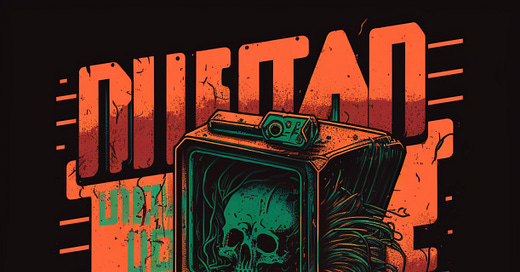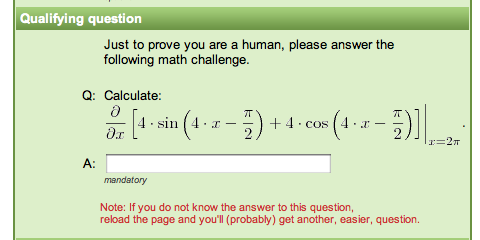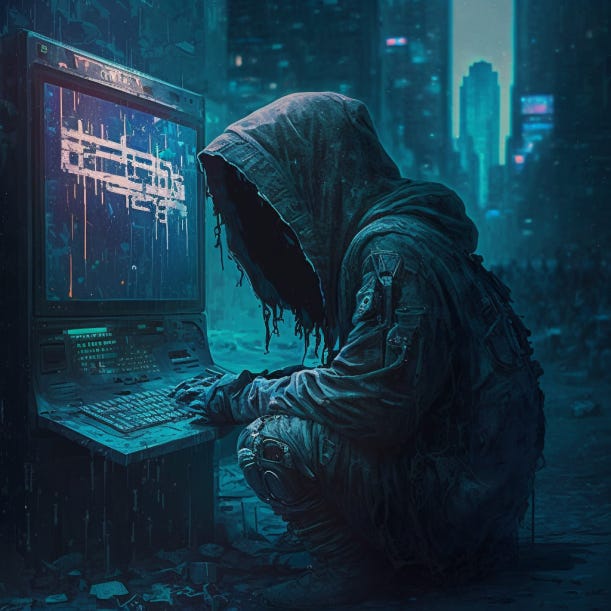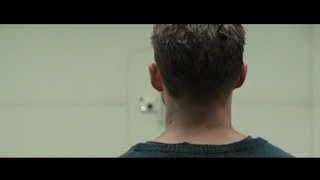Have you plucked away at this thing they call the ‘Internet’ lately? Checked the news, watched an instructional video, browsed desultorily for interesting corners? Notice anything unusual? Like the lack of warmth, the moribund pallor? The breathless unresponsiveness? Maybe we should take its pulse. What’s that? It works just fine, you say?
Ah, allow me to elaborate.
What They Promised Us
Ideas.
The world runs on them: the marketplace of ideas. Or so they told us. Plurality of thought, free expression and ingenuity, novelty. They filled our heads with candied dreams of endlessly-spanning information super-highways. The World Wide Web, was the revolution to end all revolutions. Netscape and AOL, those early lawless pirate days of the boundless unknown.
At that golden fin de siècle of Y2K, where promised dreams felt limitless and infinite beneath the neon daze of confetti-striped streets, we looked ahead to a new age brimming with open expansiveness, optimistically shushing the pablum-spouting malcontents who might’ve presaged the coming doom like some Times Square vagrant shouting ‘Repent!’
It was all supposed to be so grand. Sweeping libraries of knowledge, fruitful cyber domains and ultimate egalitarian functionality at the touch of a button, or the scuzzy tone of that 9600 baud AOL server hand-shake.
Connect with your friends, they said. Share knowledge, they said. What could go wrong?
But what did we get instead? A seedy panopticon of intrusion and broken bloatware bogging up every last dying pixel of our imported screens. Let’s run down the list of grievances, shall we?
Digital Hell
There was once a day, so long ago that it now flirts with ethereality, like a dream figment, or a pleasant, summery scent—where one recalls surfing a multitude of websites, each unique in its own way. Like the mom-and-pop boutiques tucked away in some quaint but quiet corner of a town with history, character, a good coffee shop or two. The curated little ‘walled gardens’ of delightful curiosities, the little safe-havens and quirky pulpits of hopes and misanthropes.
Oh, those were plum days.
Now, one can hardly check the weather without a withering barrage of pop-ups and eye-splattering Captchas (decollate the bastard who invented those)—the patience-testing digital Koans which seem custom-made to irritate, incite, and befog; a sort of cruel jest of social experimentation by the Wicked Wizards leering down at us from on high of the Silicon Valley welkin.
Click open almost any website today, and you’re like as not to be hit with the dreaded ‘Cookie Acceptance’ prompt, which conveniently encompasses 49.99% of the screen—so as to stay within regulation. A modern flourish that has nearly, single-handedly made the internet as unnavigable as the Bering Sea in winter.
Between that, the egregious surfeit of ads and onerous tracking architecture, the average website feels too clunky to even use—forget trying it on a moderately older, slower computer. Even on one humming with oodles of ram, it’s often a sisyphean drag to wade through the nested digital-hell of most of today’s web offerings.
Passwords are a nightmare to both create and request, should you forget yours—every interface now gropes for your cellphone like it’s the last hit of fentanyl—a standard so swiftly and undemocratically adopted it makes one wonder what other ‘new normals’ await us.
Couple that with the ubiquitous spread of paywalls and the cramming of ‘auto-play’ videos in every nook and corner—forcing you into a tedious game of whack-a-mole in attempt to disable them. Just getting to the main quiddity of a site these days feels like wading through mush; one must work through layers of labyrinthine obstructions just to denude your screen enough to make out a single stinking legible sentence. And then what are you left with?
The content itself. Oh, the content.
Where do we start? The modern website—not dissimilar to the clade of YouTube Video—is bedrocked solely on the pillars of: ‘monetization’. That means every conceivable ergonomic, UI, and user experience manifestation is completely at the behest of keeping eyes glued, fingers clicking, souls sacrificing at the inhuman altar of ‘Metrics’.
This translates into padding every square-inch of textual real-estate with as much empty fluff and flummery as possible, so as to keep those digital bean-counters whirring along. In real terms, it means the first 70-85% of every article you find is blighted like a limpet-wracked whaler hull with verbal noise: empty blather, unneeded setup and ‘contextualizations’, unasked for historical background and explanatory longueur which seems to drag on forever and ever, and can be confidently skipped. Finding a ‘How-To’ tutorial these days is an exercise in futility; one must negotiate a gamut of dead-ends and verbal off-ramps to reach the pith.
Oh, but if it weren’t for the irritation of it all!
Before the era of Google Adsense turned the Web into a hypermarket of sleezy commercialization and transactionalism, many websites retained a sense of dignity—not to speak of originality—in their point-to-point directness. Now, everything is a see-through contrivance geared wholly towards keeping you somnambulantly ‘plugged in’ to the almighty Adsense Matrix.
It all seemed to go down hill around the mid-2000’s, when the first inkling of the ‘Big Tech’ sprawl began to eat its way through the astro-turfed soil of the digital world like acid rain, greedily gobbling up all that was pure and genuine as they coalesced into the monopolistic godheads they now so unabashedly represent.
Then, as the Obama Era unleashed a rogue-wave of cultural disintegration, birthing the modern Woke Era, with its attendant digital sequestrations and industrial-scale deplatforming, the ‘Web’ turned another critical corner in its descent toward moribundity. The now-dominant Big Tech Hall Monitors became riot-police and gatekeeper in one, smoting down the sunless pate of any poor schmo who dared lean an elbow on the hallowed sill of the ever-shrinking Overton Window.
Now that garrote has squeezed the life and diversity out of the user experience, watering it down into a bland tasteless concoction. Take, for instance, YouTube’s complete abolishment of Likes and Dislikes—in one fell swoop degrading the utility of its service for countless users who relied on the ratios to make quick value judgements on a video’s authenticity. The trend has metastasized to countless mainstay sites, which completely did away with their comments sections so as to stem the selfsame growing tide of societal discontent that their own policies helped foment.
And as for videos—the bloat has extended here most of all: As a rule, any video these days can be confidently skipped to at least the five minute mark, without losing anything of its essence. With some experimentation, one can even daringly scroll twelve or even fifteen minutes deep, and still be none the poorer for it. That’s if one even makes it past the unskippable miasma of ads fogging up the opening like sewer steam.
The videos themselves, already bookended and flyleafed by a hail of YouTube’s own ads, now regularly feature a double-wall of the content-creator’s own two-fisted dip into the capitalist cookie jar—that dreaded parenthesis of awkward product-pumping which usually finds the presenters themselves looking mildly apologetic, or downright uncomfortable for subjecting you to the annoyance. And what’s with the voices? It’s as if the algorithm was designed to pluck out the creators most capable of monotoning a shrill soundwall of leafy word-salad to stultify you into the bed-eyed stupor necessary to keep you feeding at the Adsense trough. Do you know anyone in real life that speaks like these people? Hypocritical of me, I know, but welcome to the dead internet, chum.
And shall we count the ways by which every conceivable online entity is today fronted by a maddeningly impenetrable, and inhumanly obscure, wall of incommunicability? Have a problem, complaint, suggestion, terminal product failure—anything at all?—then good luck. These dystopianly barren frontages are the homeless spikes and hostile architecture equivalents of our e-panopticon. Designed to spec in adherence with the famous 1940’s CIA corporate sabotage manual—they seem purpose-built to not only dull your ability to complain or protest, but to even care at all. This deliberate digi-chasm works as intended in protecting the ruling class from blowback, while they dragoon their disenfranchised human cattle into their cyber-sheepfolds.
When you unwittingly ‘violate’ one of the mindlessly byzantine ‘codes of conduct’, you’re sent unceremoniously packing to your digital isolation cell with nary the ability to rebut the charges, or even seek clarification from a Real Live Human. No, these e-pens are designed to keep you tagged and earmarked—unworthy of human response.
It gives these towering silly conmen—errr...Silicon men—immunity and exemption. Plausible deniability from all the anti-human policies they so hubristically cram into that impious unHoly Writ of their sacred ‘TOS’.
Just try to seek clarification, or point out one of the endless inconsistencies or mind-numbing logical faults of their rules, and you’ll get nothing but a minimalist prompt, with a few inadequate choices through which to lodge your pointless complaint.
Vacuous Landscapes
These days I find myself returning to the same two or three pages, absently ‘refreshing’ ad nauseam, in the dim hopes that some middling novelty will rear its head to jolt me awake, or send me back to those elysian days of bespoke www experiences, where one could stumble on a gem like Gene Ray’s TimeCube with the same maiden awe of a xenologist making first contact.
What was once a thriving ecosystem of web locales, authored with distinction and personality—a biodiverse bloom of the interesting and outlandish, the outré and quirky and sui generis—has been displaced by a collection heap of homogenized ‘E-Commerce’ cyber-edifices, evoking the sterilization of Middle America into an endless sprawl of hyper-commercialized blandness.
No more uniquely manicured ‘walled gardens’ for the connoisseurs, the curated boutique shops and tailored ugly dolls of the cyber-world—just bloated, faceless digi-brutalism min-maxed to appease the implacable SEO gods.
Between the trackers that record your every online movement, search, and thought, then churn out eerily intrusive ads, and the general overladen clunkiness, it’s simply become a chore to navigate most sites. But beyond the weary bellyaching which threatens to turn me into the quintessential fist-quaking grandpa, the simple fact remains: it’s a stark realization that, one time long ago, I—and other people around me—once subscribed to a much wider array of websites. These days, only a tiny repetitive handful remains worthy of daily patronage. Why is that?
A Ray Of Hope?
Upon my first foray into Bitchute two years ago, I was pleasantly jarred to stumble upon a secret garden of oddities, locked away from that sterilized online milieu of Big Tech Hall Monitors. Transfixed, I sat watching the almost hypnotic rumblings of a transgender alt-right, conservative, Republican who was anti-trans rights. It was immaterial whether I agreed with them or not—the simple fact of knowing such outright interesting, transgressive voices even existed was a dawning moment which shone a light on how far the ‘algorithms’ of the digital panopticon had actually regressed and repressed our human experience.
There’s a precariously diminishing amount of spaces where such voices would be given platform at all. Certainly, the anti-human algorithms of YouTube would never allow you to glimpse such pirate transmissions from the truly subversive underground. No, their narrative-spinning video feeds are carefully, algorithmically crafted to serve up a narrow strain of humanity, to prevent our minds from being polluted by the actual, classification-bucking reality.
Substack, too, feels like an oasis—for now at least—where genuine, independent dissident thought appears to flower in the mildewed darkness beneath the overpass, without the specter of deplatformization constantly hanging overhead like some lurid swamplight. WordPress and most of the others continue to deplatform many a ‘heterodox heretic’.
Living Dead
The nominally coined ‘dead internet theory’ revolves around the idea that bots and AI are turning the net into an artificial goop of endlessly reverberating algorithms, which in essence create a simulacra-simulation matrix of surrogate activity, a sort of human facsimile echo-chamber where actual humans are increasingly left out in the cold looking in, as disenfranchised spectators. One foray into Twitter discourse leaves one with the feeling it may not be far from the truth.
ChatGTP and a variety of other new seemingly near-sentient AI bots are already in widespread use, and are set to overtake the journalism and article writing fields. Everything from companies to content creators are already using these AI for a variety of purposes. A judge in Colombia has used the AI to make a ruling on a case, and the bot is now being regularly used to pen spammy internet articles, social media posts, college entry exams, craft market strategies, and a host of other things.
But the eerier usage results from pairing an AI like ChatGTP with other AI-generated products like avatars and voices, to create a full-on life-like digital facsimile:
A new generation of such surrogate ‘humans’ could soon comprise a growing moiety of online ‘discourse’ in a way that no longer allows human observers to distinguish the figures they’re following from bios and synthetes. More radical proponents of ‘dead internet theory’ believe that that critical mass has already been reached, and a majority of online colloquy has already been supplanted by bots flaming bots.
This gets into particularly murky territory when full-blown deepfakes of the following sort begin duping people en masse in a variety of human experience venues, be they political, philosophical, cultural, etc:

Most reactionary worries revolve around the dreaded possibility of WW3 being haplessly triggered by some deepfake or AI. But a lesser explored possibility is the creation of a new league of online messiahs; ideologues preaching from their bully pulpits, which may turn out to be just bots shepherding (or culling?) their herd toward some unforeseeable sociopolitical-interspecies nexus.
It might be an exciting prospect for some—and certainly it’s a thrilling time of ‘future-shock’ we’re careening through. But what will it mean for the rest of us biogens if the ‘internet’ descends into even further regions of obscure meta-incommensurability, a sort of digital transfiguration, leaving the rest of the drab and shabby, the hopeless petitioners merely tithing at the AI alms spigot?
For now, I suppose, we can carry on, huddling in our little vagrant spaces, on the unpaved lanes serving as the mossy detours of the now defunct ‘Information Superhighway’ once promised us. Maybe we’ll be the coin-cup-shaking fools, strapped beneath the concrete underpass, muttering our convolutions to any passerby who’ll spare an ear.
Could be that’s what I already am. So here’s my cup:













Your essay mirrors my own experience: this is where we are, this is where we came from - and horrifyingly this is where we're going: a dystopia where 'Generation Smartphone' doesn't even realise how brainwashed they are because 'what is real' is that which they see 'with their own eyes' on their smartphones. Never mind that this 'reality' has already been 'curated' to an extent that even mild opposition is intolerable to them. Never mind that this 'reality' is more and more divorced from what is really going on. Never mind that that 'reality' will be even more monetarist where the latest shiny bauble of 'News - look here, don't look there' won't even need to be reinforced ...
Gawd, I'm glad I'm old enough to remember 'LBI': Life Before the Internet' ...
Thanks for this essay!
solving Captchas to prove we're human is a parody at this point. How about the corporations solve MY captcha to prove they're human?